Reviews
‘Darkest Dungeon II’ Review – How the New Sequel Improves Upon an Already Great Game

I’ve scraped through two fights in the Great Library, destroying mad cultists and immolators, and now am faced with the sinister Librarian. The Plague Doctor, my only character with healing skills, is low on health and high on stress, a bad combination for a challenging encounter. The Librarian hurls a flaming book at her, putting her at death’s door and maxing out her stress. There’s a tense moment as her resolve is tested before she becomes resolute, an unexpected boon that turns the tides of battle. These are the ups and downs you can expect playing Darkest Dungeon II, Red Hook Studio’s followup to their breakout hit.
For those familiar with the 2016 original, you will find comfort in the similarities. You’re still sending parties of four adventurers to face all types of cultists, creatures and eldritch abominations as you try to cleanse the lands of ancient evil. The tight turn-based, positional combat returns as well, but the overall structure of the game has been completely redone. Instead of the XCOM-like structure where you build a large pool of units to pull from for each dungeon delve, it presents a roguelike structure where you select a core team of four that you’ll take on a longer run through one of five campaigns, each with different environments and bosses. As a long time fan of Darkest Dungeon, it was a jarring change to say the least, but the benefits of the new approach quickly made themselves apparent.
Make no mistake, this sequel still has Darkest Dungeon’s signature brutal difficulty, but the structure makes losses feel like less of a waste of time and more like another step in the journey. Rather than delving into actual dungeons, you’ll guide a stagecoach carrying your four heroes through an environment full of forking paths. Each path will lead you to various encounters and events that will affect your journey in significant ways, so choosing the correct fork on the road is crucial. One path may have a meeting with a merchant, but is preceded by a treacherous section that will damage your carriage, while another path may lead to a hospital with a battle to complete on the way. It’s a tried and true formula in the roguelike space, but the risk-reward calculations are always satisfying and meaningful.
Even in failure, each run will grant you candles, a currency that allows you to unlock new characters, upgrade current ones or provide permanent buffs to your party on future runs. As you improve each character, you’ll also unlock paths for them that can be selected at the beginning of a run. Each path changes the character’s base stats and skills in some way, giving them a slightly different focus in battle. These additional options and improvements will grant you more options in building out your team, so it’s often worth seeking out candles even if it means possibly dooming your current run.
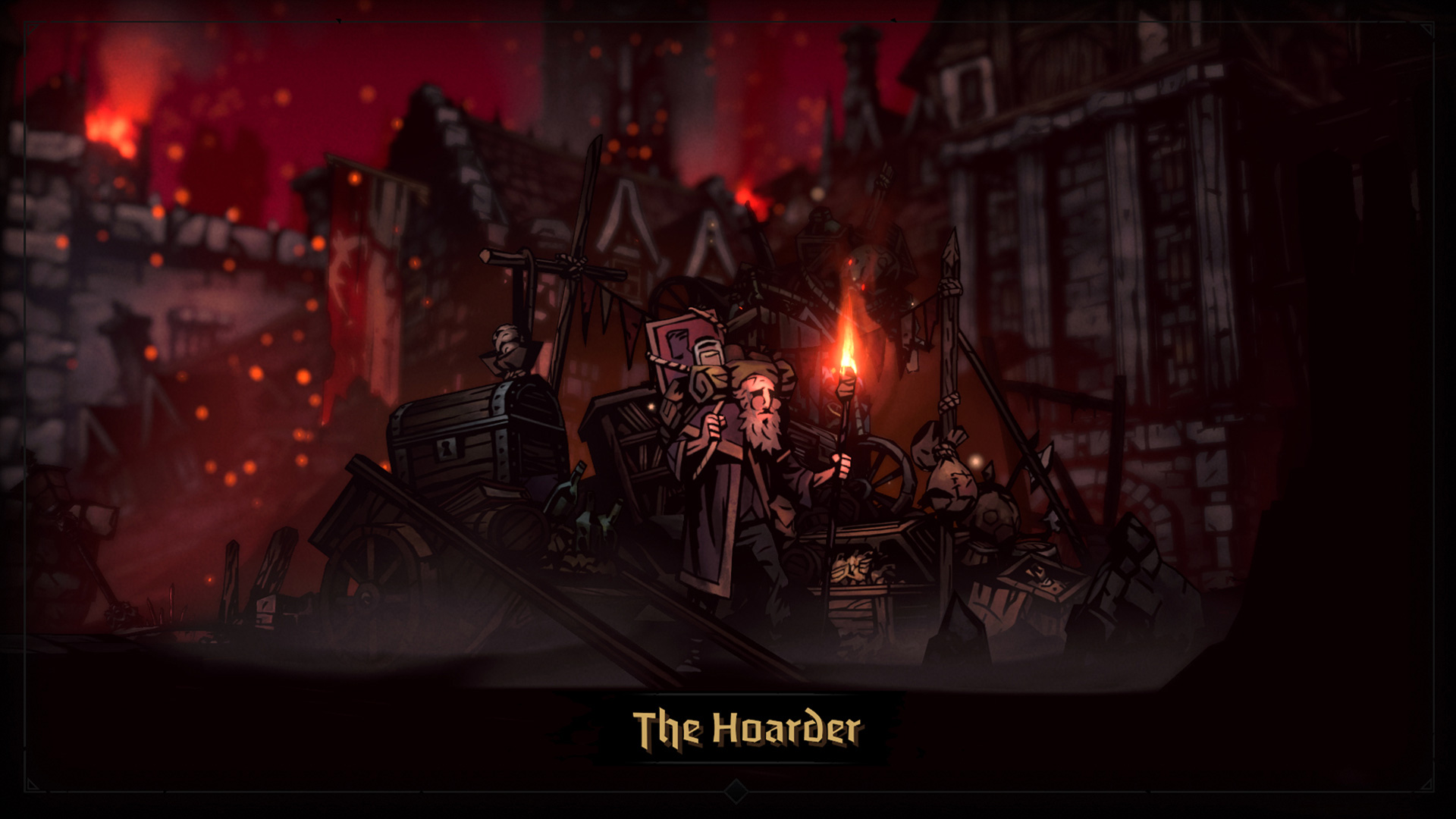
Each run is broken up into regions, with stops at an inn acting as a place to rest up and spend currency. You’ll purchase trinkets or combat items, improve character abilities with mastery points you’ve earned through battle, and repair damages to your carriage. Certain items can exclusively be used at the inn, which generally helps by giving characters buff that will continue until the next region, so it’s important to spend your money wisely on whatever will help your party the most. If you’ve lost any characters in the previous region, it will backfill with other heroes you’ve unlocked. While this may seem really powerful, because of the fact that your characters have such specific roles on the team, it’s hard to slot a random character into your perfectly balanced party.
With the increased affinity that comes from taking a single party through a long quest, it’s a lot easier to get invested in your specific characters rather than treating them as more grist for the mill. The Hellion you’ve chosen for this mission is not just a Hellion, but THE Hellion, so you grow more attached. To go along with this new attachment to the characters is a relationship system that allows them to grow closer or further apart as the stress mounts during their travels. These can culminate in relationships that give you buffs or debuffs upon use of specific attacks, so it’s important to encourage these relationships by managing stress and using the right items at inns.
One of the areas you encounter as you travel through a region is the Hero Shrine. At a Hero Shrine, you can select one party member and get a glimpse into their backstory. Each hero has five chapters in their origin, and each chapter permanently unlocks a new combat skill for them. Some of these chapters will take the standard combat gameplay and mix it up in clever ways to tell a short story, transforming the battle system into a scholarly debate or a prison break. It’s a small but ingenious addition that mixes narrative and gameplay benefits into the already winning formula.

The turn-based combat from the original returns, but with smart wrinkles that make it both more dynamic and readable. Your characters still occupy a specific spot in your marching order, with certain abilities being locked to certain places in the order. It’s crucial to make sure you have proper coverage throughout the marching order to optimize your attack options. As you unlock paths and abilities, characters can become more versatile and be used in previously unheard of ways. There are twelve heroes in total, 11 returning and one new face, and each feels unique in utility and flavor.
The new token system in battle allows you to place buffs and debuffs on your heroes and enemies that have clearly defined effects and durations. For example, your attack may put a vulnerable token on its target, which means the next attack against it deals 50 percent additional damage. Certain skills also place a combo token, which has variable effect depending on the skill used next. The Man-at-Arms will get healed when using his mace on an enemy with a combo token, while other classes might just get a damage boost. Finding these synergies between your party is the key to victory, as battles remain tactically challenging. No fight is trivial, keeping you on your toes at all times to make sure a simple mistake doesn’t snowball into a total party kill.
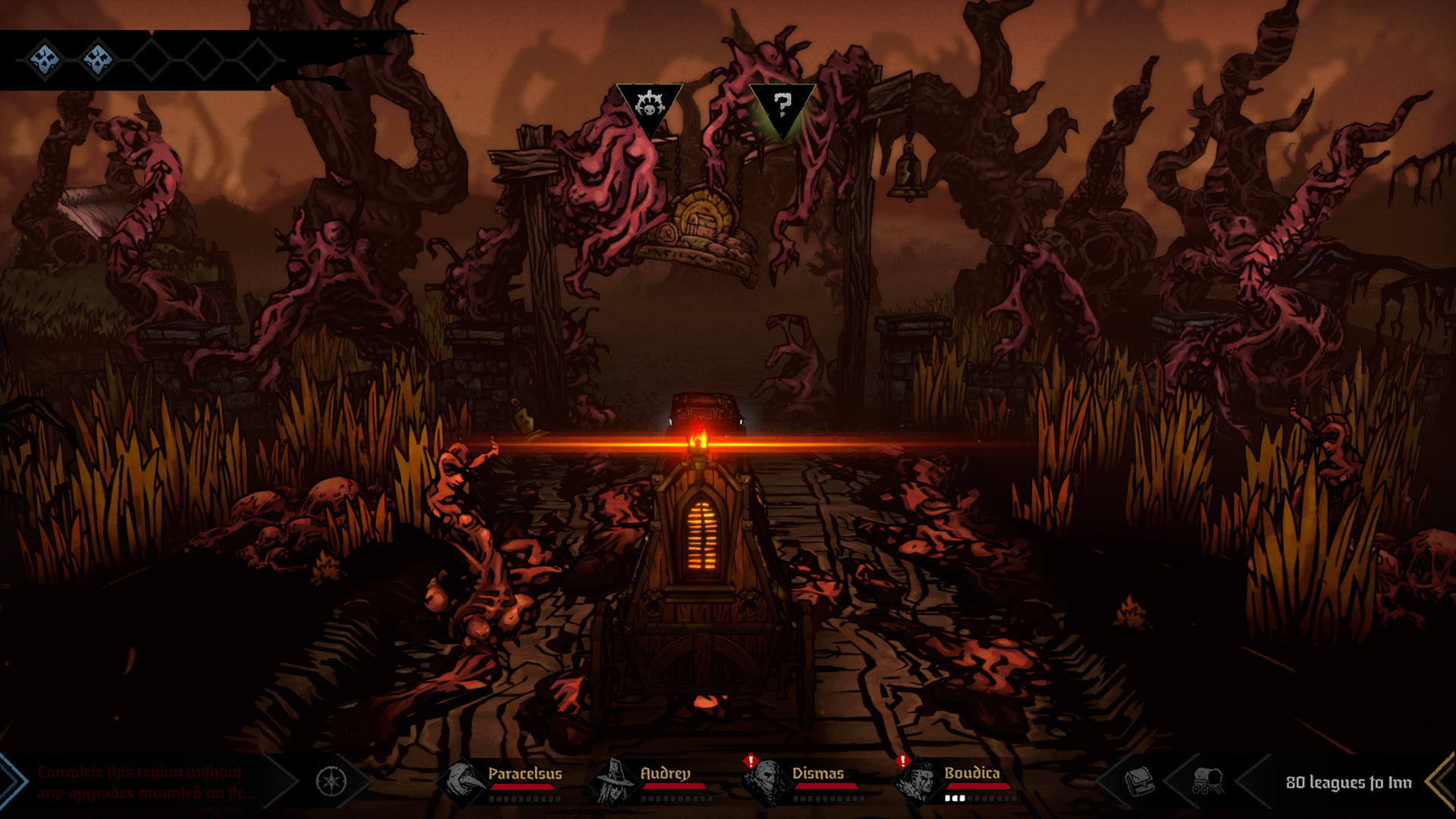
Darkest Dungeon immediately made an impact with its gorgeous 2D art style, so there was some trepidation when I saw the sequel moving into 3D, but I was completely shocked with how stunning the game looks in its new style. It still has the heavy line, Mike Mignola-like look that conveys the tone of the dark and grim setting, but the new animation breathes so much life into every moment. It still uses the signature freeze-frame to emphasize each attack animation, but there are little touches going into and out of each that look amazing. Enemy designs also shine in the new style, rendering these Lovecraftian horrors in great detail. The environments you traverse are always a wonder to behold, even if it’s a bit dull to have to manually drive the carriage through the regions.
I’m extremely glad that Red Hook Studio took a risk and changed up the metagame for their sequel. Not only does the roguelike structure provide meaningful and satisfying choices both within runs and between them, but it also fixes problems many people had with the overall punishing nature of the first game. In the original, nothing felt more demoralizing than a full party wipe with a set of level six characters. The amount of work each of those represented was substantial, and it took a long time to bring a new character back up to that level. In Darkest Dungeon II, even though these runs can take several hours to reach the end boss, the ability to upgrade your characters and carriage after a loss makes it all feel worth it. This choice effortlessly retains the punishing difficulty without the soul-crushing feeling of defeat.
Even after you finish all five campaigns, you can equip Stygian Flames that will make your run more difficult, giving you plenty of reason to continue to throw yourself at new challenges. It’s hard to say so soon after release if Darkest Dungeon II will stand the test of time in the same way as the original, which is one of my all-time favorite games, but at the very least new format justifies the new game rather than feeling like a retread of the familiar ground of the first one. No matter how devastating the loss, I always find myself ready to load up one more run of Darkest Dungeon II, which is the sign of a successful roguelike, so it’s possible that this will become my go to version of the franchise.

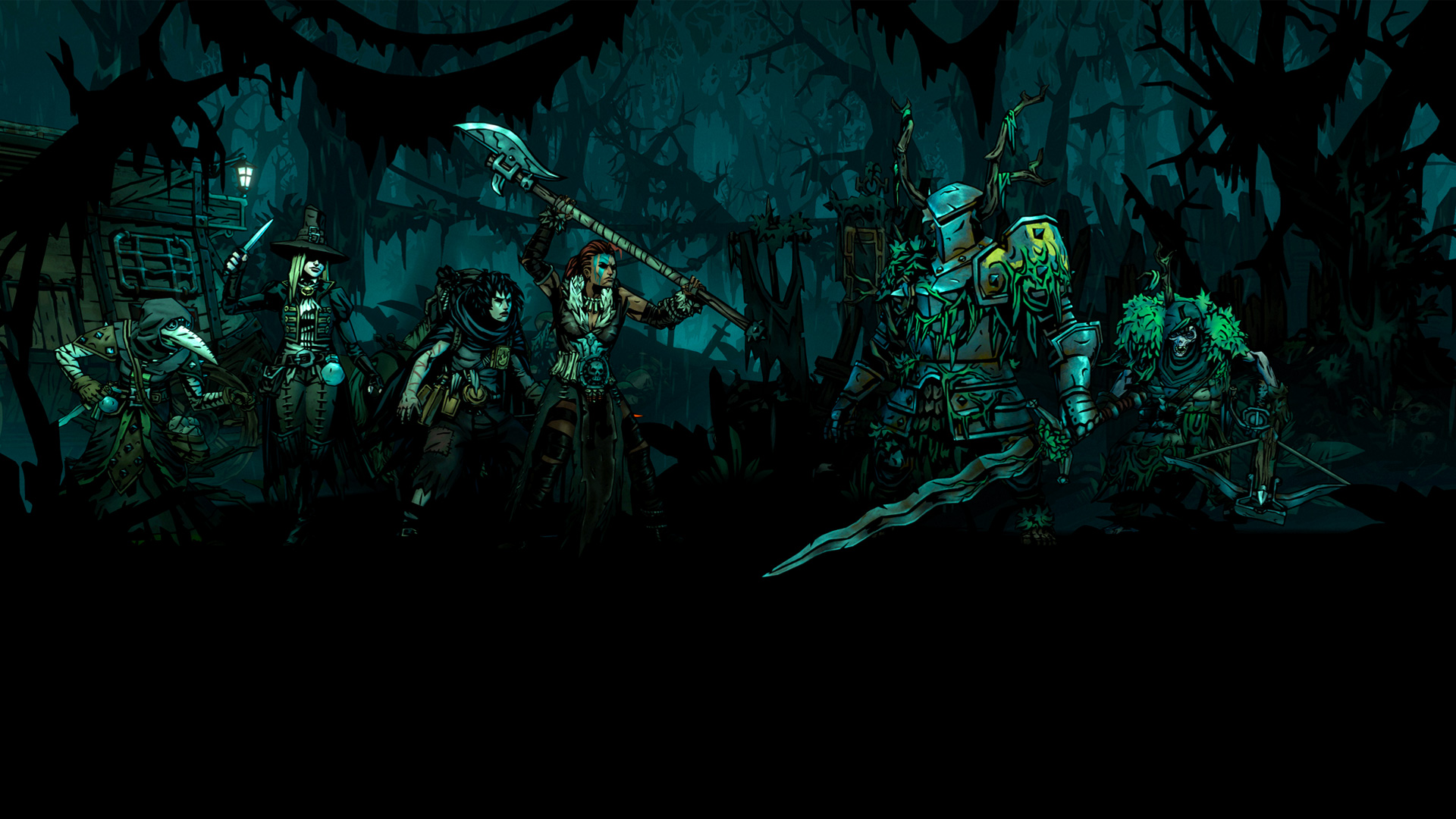

Movies
‘Project Silence’ Review – Killer Dogs Make This Korean Disaster Movie Unique

The “disaster movie” is not quite as visible as it used to be in Hollywood, but thankfully for fans, South Korea has more than picked up the slack. In just the last two decades, Koreans have had to deal with a variety of catastrophes on screen, including a tsunami, a collapsed tunnel, an unstable power plant, and multiple zombie outbreaks. The latest offering in this genre, however, stands out from all the rest. Not because the disaster in question is unique; a bridge pile-up is only the beginning in Kim Tae-gon‘s Project Silence.
This movie doesn’t waste any time getting to its main attraction; after their cursory and brief introductions, the core characters all make their way to the ill-fated bridge where multiple dangers loom. When this looks to be another case of rag-tag strangers coming together for their collective survival — and it very much is one — the initial ordeal is topped off with a second helping of calamity. Straight out of left field, the story introduces a pack of killer dogs. These top secret and military trained mutts escape their masters, ignore commands, and then go berserk on the bridge survivors. The ensuing dog-on-human mayhem is less intense than you might have anticipated or desired, yet these encounters grow in number as the pared-down cast searches for help and explores the creatures’ origin.
Project Silence refreshingly comes in under 100 minutes, and its tights-as-braids pacing leaves virtually no time for collecting your breath or developing the characters. Apart from the hero, a single dad and sometimes unethical aide for a presidential candidate (Lee Sun-kyun, Parasite), everyone coasts on their meager characterizations rather than grows. Lee’s character can be especially difficult to get behind, due in large part to his compromised ethics, but his flaws also make him a tad more interesting than the usual key players in these kinds of movies. As for his character’s teenage daughter (Kim Su-an, Train to Busan), she eventually escapes her dual role as damsel-in-distress and her father’s moral compass. Directly supporting the central family dynamic is a wacky tow truck driver (Ju Ji-hoon) whose comic relief and pluckiness break up this situation’s direness.
Considering all the scenes of extensive dog action, Project Silence relies on digital effects. The stunts require much more than a real dog could or should pull off. The bleak and foggy environment helps to obscure the uncanny valley effect, although you are never at all convinced these are anything other than CGI dogs. Nonetheless, this is not a cheap movie, and the money is evident on screen. Even the four-legged antagonists — whose backstory will tug at animal lovers’ hearts, regardless of their artifice — are occasionally impressive. The disaster set-pieces, on the other hand, are consistently fun, if not fleeting; their immersive designs and thrilling executions get the blood pumping.
The late Lee Sun-kyun turned in a solid final performance, boosting the profile of an expensive “B” movie. The energetic, unflinching execution also compensates for any less innovative and more predictable parts. Without its random creature-feature aspect, though, Project Silence would likely go undetected or be soon forgotten. Fortunately, the dog element gives this movie a better chance of survival.
Project Silence is now playing in select U.S. theaters.


Image: Poster for Project Silence courtesy of Capelight Pictures.



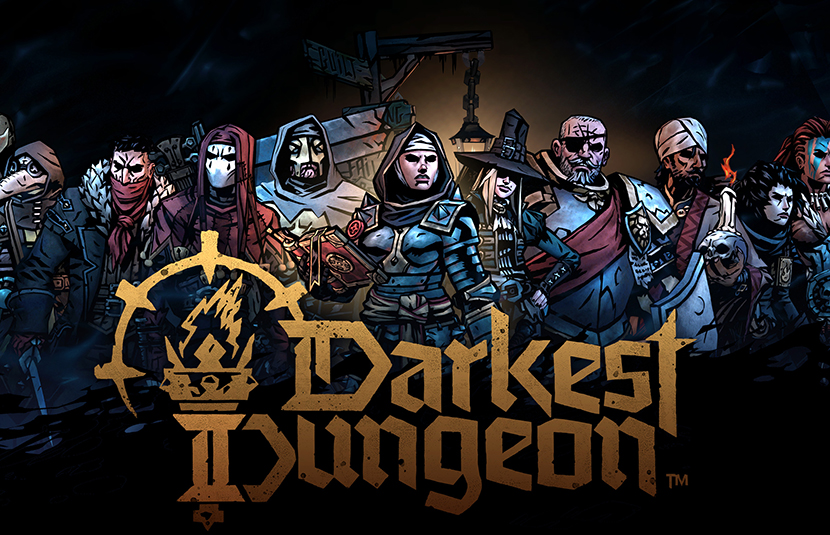

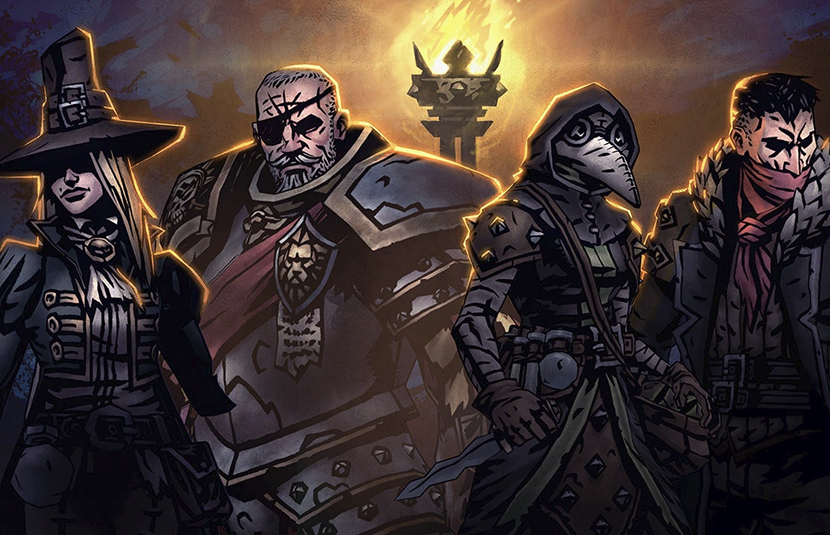







You must be logged in to post a comment.